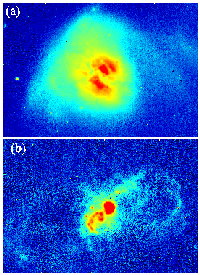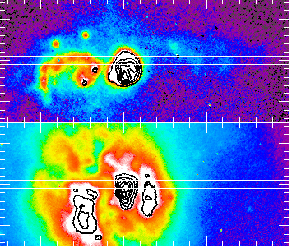
Complex Structure of the Superwind-Driven
Nebula around the Ultraluminous Infrared Galaxy Arp 220
Youichi Ohyama (NAOJ-Subaru), Yoshiaki Taniguchi (Tohoku Univ),
J. E. Hibbard (NRAO), William D. Vacca (MPIfE),
Michitoshi Yoshida (NAOJ-OAO), Nobunari Kashikawa (NAOJ).
In preparation
We present results of new optical narrow-band imaging and long-slit
spectroscopy of a superwind-driven nebula around an archetypical
ultraluminous infrared galaxy, Arp 220. Although the nebula is known
to show a simple "figure-8" shaped morphology and is often recognized
as a pair of twin bubbles, we find that the nebula has rather complex
properties than expected from its simple appearance. In Ha+[NII]
image, we identify two more pairs of smaller shell-like morphological
features within the twin bubbles previously known. By analyzing the
kinematical structure along the major axis of the nebula, we find that
the inner region between 6" ~ SE and 2" ~ NW shows a broad
emission-line component whose full width at half maximum (FWHM) varies
from ~500 km/s to 1200 km/s as well as the narrow one with FWHM ~250
km/s. On one hand, a double-peaked narrow profile is found at 6-9"
SE, ~12" SE, and 11" NW and a single narrow blue-shifted profile is
found in the remaining parts. These complex morphological and
kinematical properties are difficult to be interpreted simply as the
effect of the expanding twin bubbles. Rather, a model of overlapping
multiple bubbles each of which has different size and kinematical
structure seems to be more preferred since each shell-like structure
seems to have its own kinematical characteristics. It is therefore
suggested that Arp 220 experienced multiple starburst events in its
central region.
Back to Arp 220 page

The Cold-Gas superwind of Arp 220 Traced by NaD5890 Line
Youichi Ohyama (NAOJ-Subaru), Yoshiaki Taniguchi (Tohoku Univ),
William D. Vacca (MPIfE), J. E. Hibbard (NRAO).
In preparation
Arp 220 is a prototypical ultraluminous infrared galaxy with evidence
for a large-scale shock-heated nebula driven by superwind activity.
We present results of our new long-slit optical spectroscopy on this
galaxy. We analyze the kinematic properties of both the Halpha and
NII (6548A, 6583A) emission lines and the Na D (5890A) absorption line
along the axis of the superwind. We find that the velocities traced by
all three lines are quite similar, with similar asymmetric and/or
double-peaked line profiles. All lines show that the outer regions (r
> 1.8 kpc) are blue-shifted by > -300 km/s. Since both Halpha and NII
emission are known to come from the shock-heated ionized gas
associated with the superwind, the line similarities indicate that the
neutral interstellar matter giving rise to the Na D absorption is also
entrained within the superwind outflow.
We also detect blue-shifted Na D in emission from outer NW regions,
suggesting that this gas is excited by the shock
between the expanding interstellar gas and the ambient matter.
The mass of the interstellar HI gas associated with the
superwind is estimated to be ~1E9 Msun, which is
roughly comparable to that of the nuclear molecular gas
disk, and is even higher than that of the
hot ionized gas (HII) within the superwind.
The energy required to blow out the HI gas (~3E57 ergs)
could be supplied by 1E8 Type II supernovae.
R data obtained from the UH 88" in 6/95
Keck LRIS Spectra obtained from Keck II with W. D. Vacca in 4/97
Ha+[NII] imaging from Subaru by Y. Ohyama in 2/00
Back to home
Maintained by
jhibbard
@ nrao.edu

